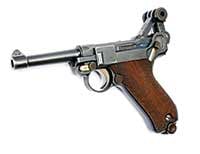Striker-Fired
What's Old Is New Again
Reader Mike Quill suggested we discuss some common terms such as “blowback” and “locked breech,” familiar terms to handgun enthusiasts, but perhaps less so to the many newcomers to handgun shooting. One of the terms he mentioned was “striker-fired” which resulted in a message from reader Tom Killgore. He noted many younger shooters seem to think striker ignition is a recent development.
“My point is the term striker-fired is being used these days … as if it is a feature that connotes a type of trigger and a type of frame construction, when in fact it just defines how the firing pin is energized.”
Mr. Killgore is absolutely right. Striker-fired, semi-auto pistols are certainly not a recent development. Striker-fired pistols were being designed, manufactured, carried and used back before Theodore Roosevelt was president, when such legendary figures of the Old West as Geronimo, Pat Garrett, Butch Cassidy and the Sundance Kid were still alive.
Actually if we include manually operated rifles in the discussion, the history goes back almost two centuries. There were striker-fired rifles being designed, and used by military forces before fixed ammunition existed. The Dreyse needle gun designed in the 1830’s was striker-fired. Almost all currently made bolt-action rifles are striker-fired, including such classics as the Remington 700 and Winchester 70.
A Classic Design
From what I’ve read, the Hugo Borchardt C-93 (1883) was the first striker-fired semi-auto pistol produced in any quantity. Although well made, the C-93 was a bulky, ungainly looking pistol. One of the people involved in testing the C-93 was Georg Luger. He addressed the various shortcomings of the C-93 to develop a practical, graceful sidearm. Luger’s design was adopted by the Swiss in 1900, and became the standard German sidearm in 1908. The striker-fired P-08 served Germany’s armed forces in two world wars.
Around the same time, John Browning designed and patented a striker-fired pistol. It would be manufactured by Fabrique Nationale (FN) in Belgium as the model 1900. Browning designed another striker-fired pistol that was produced by FN as the model 1910.
Both FN pistols (and a 1922 variation) proved extremely popular. In fact counting just the pre-WWI Luger and the FN pistols, total production was likely around five million striker-fired pistols. In the early years of the 20th century several more striker-fired pistols were introduced by companies such as Mauser, Sauer and Savage.
Hammers have been used on firearms since the days of flintlocks and caplocks, right up to the present day. With some revolvers the firing pin is attached to the hammer and extends through the frame to strike and ignite the cartridge primer. With other designs the firing pin is a separate component. When the trigger is pressed the hammer is released to strike the firing pin which in turn strikes the primer.
Striker Design
With striker-fired designs there’s no hammer and the firing pin is incorporated in a component called (duh!) the striker. The striker has a lip to engage the sear, and is powered by a spring. When the trigger is pressed the sear releases the striker to drive forward and strike the primer.
Striker firing is a feature of many recent designs, which I suppose is why so many think it’s something new. It’s a fairly simple concept, not a bad thing as simplicity is often associated with reliability, durability and ease of manufacture. Personally I can’t get too excited about hammer vs. striker ignition. I have many handguns of both designs and can’t say I care much one way or the other. Advantages and disadvantages are more theoretical than real.
As mentioned earlier, striker-fired semi autos were available at a time when a few legends of the Old West were alive. I can’t find information on whether these old-timers actually owned or used such designs but one who did (or rather tried to) use such a pistol, was controversial figure Tom Horn. In 1903 while awaiting execution for murder, Horn and another prisoner made an escape attempt. He grabbed a semi-auto pistol owned by a deputy sheriff. According to the story Horn was unable to figure out how to fire the pistol and was quickly recaptured. Some sources say the pistol was a 1900 Luger. Others say it was an FN 1900, s/n 56666.
“Bat” Masterson relied on Colt single-action revolvers in his days in the Old West. His later years (he died in 1921) were spent working as a sports writer in New York. He appeared in an ad endorsing a Savage pistol, a 10-shot, striker-fired semi auto. Not much new under the sun!







